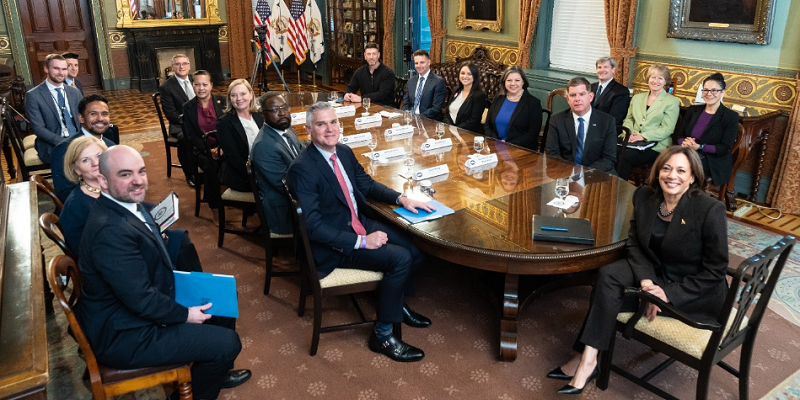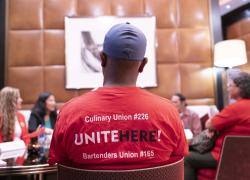
On Friday, March 10, in former Secretary Marty Walsh’s last public event in office, the White House Task Force on Worker Organizing and Empowerment, chaired by Vice President Kamala Harris and vice chaired by Secretary Walsh, held a roundtable discussion with employers and unionized workers on the benefits of collective bargaining and positive labor-management relations. The companies and unions featured at the event included Ford and the United Auto Workers, Orsted and North America’s Building Trades Unions, Microsoft and the Communications Workers of America, and Siemens and the International Brotherhood of Electrical Workers. In a follow-up to the event, the task force released an update on the status of the 70+ action items in the first task force report and more than 30 additional actions that have been taken by agencies across the government.
It was a fitting way for Secretary Walsh, a card-carrying union member and the first union member to lead the Labor Department in more than half a century, to conclude his time as labor secretary. During his tenure, Secretary Walsh worked tirelessly to support the collective bargaining process, help workers and employers reach agreements, and settle disputes. And through Secretary Walsh’s and Vice President Harris’ leadership of the task force, the 20 agencies and offices on it have found ways to reduce barriers to organizing and support workers and their organizing rights. As importantly, the task force has provided a vehicle for a governmentwide discussion of the value and importance of unions to workers (both union and non-union), employers and our economy.
Another exciting aspect of the task force is how it has brought agencies together to collaborate in new ways on supporting workers’ rights. This has included actions by the independent labor agencies – the National Labor Relations Board, the Federal Mediation and Conciliation Service, the Federal Labor Relations Authority and the National Mediation Board – who, while not on the task force, have made important contributions to its work. For example, the NLRB and FMCS are pursuing an initiative to help the parties bargain a first contract when workers first organize – a persistent challenge workers face.
These agencies also have provided valuable content to the Labor Department’s Worker Organizing Resource and Knowledge (WORK) Center, our one-stop shop for information on unions and the union advantage, and to worker.gov, a plain language website with information on key worker rights, including organizing rights and protections against retaliation. The Labor Department, the FMCS and the NLRB also collaborated with the Small Business Administration on the first resource guide for small businesses on unions, workers’ right to organize and employer responsibilities in worker organizing campaigns.
Additionally, the departments of Labor and Commerce have collaborated on Good Jobs Principles, which include respect for workers’ right to organize. The whole-of-government approach of the task force has encouraged interagency collaborations like these, with more to come in the future.
At the Labor Department, we have made significant progress on our task force action items. Here are a few highlights:
-
We're getting information on unions and organizing into the hands of workers who need it to help close the enormous gap between the percentage of workers who want union representation (52%) and the percentage of workers who say they have the information they need to form a union (10%).
-
We are working to highlight case studies of employers who take a constructive view of worker organizing and elect not to run anti-union campaigns when their workers choose to organize – a positive trend that more employers are choosing to follow, according to a recent report.
-
The department’s Office of Labor-Management Standards has reinstituted a Labor-Management Partnership Program to highlight and encourage this approach. As the task force event earlier this month demonstrated, when employers take a constructive approach to worker organizing and collective bargaining, their businesses benefit through greater productivity, less turnover and more satisfied workers.
The Biden-Harris administration has sent a clear message to its agencies to find ways to support workers and their right to organize, and, under the leadership of Acting Secretary Julie Su, the Department of Labor’s commitment to this work will continue unabated.
Lynn Rhinehart is a senior counselor in the Office of the Secretary at the U.S. Department of Labor.

 U.S. Department of Labor Blog
U.S. Department of Labor Blog
